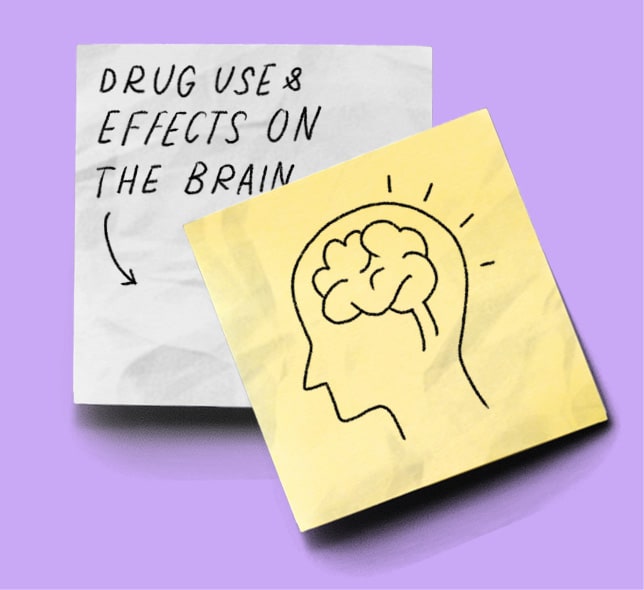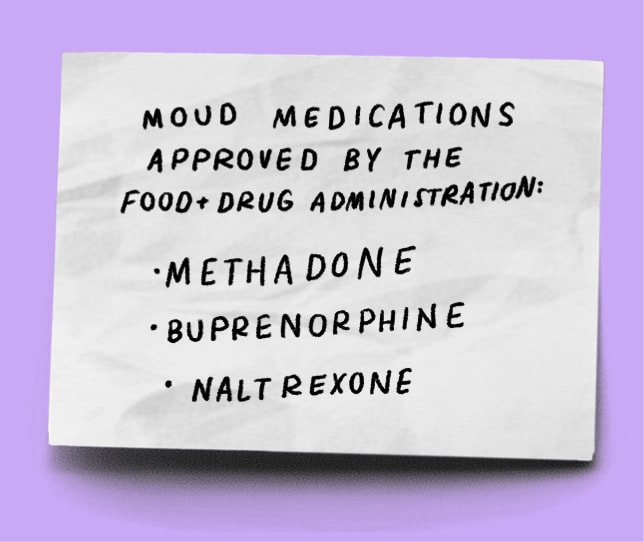Addiction can happen to anyone
One in 7 Americans reports experiencing a substance use disorder. There is not one single driving factor that leads to addiction. Some people may use drugs to help cope with stress, trauma, or to help with mental health issues. Some may even develop opioid use disorder after misusing opioids they are prescribed by doctors. In any case, using drugs over time makes it easier to become addicted.
Drug use and effects on the brain

When people take drugs, the brain is flooded with chemicals that take over the brain’s reward system and cause them to repeat behaviors that feel good but aren’t healthy.
The brain adapts to continued drug use by developing a tolerance, which means it takes more of a drug to feel the same result.
Not only does this lessen the brain’s ability to resist temptation, but it can also affect the amount of pleasure a person receives from normal, healthy activities like enjoying food or the company of others.
Substance use disorder (SUD)
Substance use disorder (SUD) is defined as a problematic pattern of substance use leading to clinically significant impairment or distress. Education and awareness around the harm of using substances, along with the support of friends, parents, and caregivers, can help prevent SUDs.
Opioid use disorder (OUD)
Opioid use disorder (OUD) is defined as a problematic pattern of opioid use that causes significant impairment or distress. About 1.6 million people in the United States suffer from OUD.1 Prescription drug monitoring programs, state prescription drug laws, and education around safe storage and disposal can help in prevent prescription opioid misuse, OUD, and overdose.
Addiction is a treatable disease
Addiction is a disease, not a character flaw. People suffering from SUDs have trouble controlling their drug use even though they know drugs are harmful.
Overcoming a SUD is not as simple as resisting the temptation to take drugs through willpower alone. Recovery may involve medication to help with cravings and withdrawal as well as different forms of therapy. It may even require checking into a rehabilitation facility. Recovery can be challenging, but it is possible.
Recovery options
There are safe and effective ways to recover from SUDs. Finding the right treatment option can be the key to a successful recovery journey.
Medications for opioid use disorder (MOUD)

Opioid use disorder may require medication as the first course of treatment. Medications for opioid use disorder (MOUD) can help with cravings and withdrawal symptoms.2 MOUD is effective in helping people overcome addiction, stay in recovery longer, and prevent reoccurrence of use.3
MOUD medications approved by the Food and Drug Administration (FDA):
- Methadone
- Buprenorphine
- Naltrexone
Taking these medications during treatment doesn’t mean taking the easy way out; it means finding something that works best for that individual.
Additional Treatment Options
- Twelve-step facilitation therapy is an individual active engagement strategy designed to encourage people to accept drug addiction as a chronic, progressive disease and prepare them to begin a 12-step mutual support program.4
- Outpatient counseling can help people understand addiction, their triggers, and their reasons for using drugs. This form of treatment can be done at a doctor’s office or via telehealth appointment.
- Inpatient rehabilitation at a full-time facility provides a supportive environment to help people recover without distractions or temptations.
Reoccurrence of use is not a sign of failure
Reoccurrence of use may happen to people who use drugs and can happen even years after not taking the substance. More than anything, reoccurrence of use may be a sign that more treatment or a different method is needed. A routine review of one’s treatment plan may be necessary to determine if another method could be more effective.
Recognizing the signs of opioid overdose can save a life. Here are some things to look for:
- Small, constricted “pinpoint pupils”
- Falling asleep or losing consciousness
- Slow, weak, or no breathing
- Choking or gurgling sounds
- Limp body
- Cold and/or clammy skin
- Discolored skin (especially in lips and nails)
Provided by:
https://www.cdc.gov/stopoverdose/stigma/index.html

